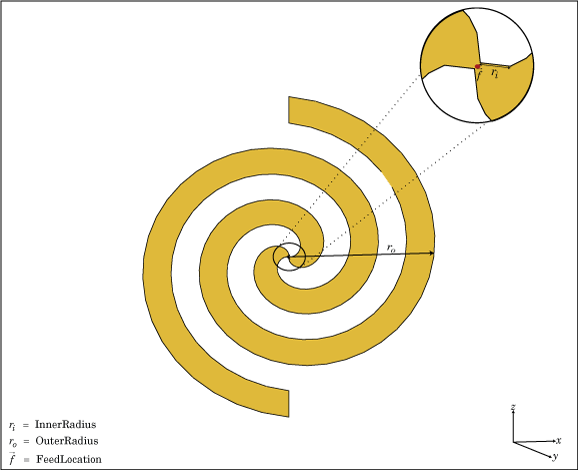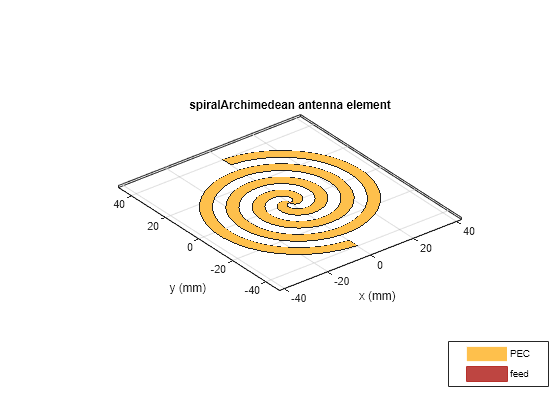spiralArchimedean
Create Archimedean spiral antenna
Description
The default spiralArchimedean object creates a planar Archimedean
spiral antenna on the xy- plane resonating around 1.46 GHz. The
default Archimedean spiral is always center fed and has two arms. The field
characteristics of this antenna are frequency independent. A realizable spiral has
finite limits on the feeding region and the outermost point of any arm of the spiral.
The spiral antenna exhibits a broadband behavior. The outer radius imposes the low
frequency limit and the inner radius imposes the high frequency limit. The arm radius
grows linearly as a function of the winding angle.
The equation of the Archimedean spiral is:
where:
r0 is the inner radius
a is the growth rate
ϕ is the winding angle of the spiral
Archimedean spiral antenna is a self-complementary structure, where the spacing between the arms and the width of the arms are equal. The default antenna is center fed. The feed point coincides with the origin. The origin is in the xy- plane.

Creation
Description
ant = spiralArchimedean
ant = spiralArchimedean(PropertyName=Value)PropertyName is the property name
and Value is the corresponding value. You can specify
several name-value arguments in any order as
PropertyName1=Value1,...,PropertyNameN=ValueN.
Properties that you do not specify, retain their default values.
For example, ant = spiralArchimedean(Turns=6.25)
creates a Archimedean spiral of 6.25 turns.
Properties
Object Functions
axialRatio | Calculate and plot axial ratio of antenna or array |
bandwidth | Calculate and plot absolute bandwidth of antenna or array |
beamwidth | Beamwidth of antenna |
charge | Charge distribution on antenna or array surface |
current | Current distribution on antenna or array surface |
design | Create antenna, array, or AI-based antenna resonating at specified frequency |
efficiency | Calculate and plot radiation efficiency of antenna or array |
EHfields | Electric and magnetic fields of antennas or embedded electric and magnetic fields of antenna element in arrays |
feedCurrent | Calculate current at feed for antenna or array |
impedance | Calculate and plot input impedance of antenna or scan impedance of array |
info | Display information about antenna, array, or platform |
memoryEstimate | Estimate memory required to solve antenna or array mesh |
mesh | Generate and view mesh for antennas, arrays, and custom shapes |
meshconfig | Change meshing mode of antenna, array, custom antenna, custom array, or custom geometry |
msiwrite | Write antenna or array analysis data to MSI planet file |
optimize | Optimize antenna and array catalog elements using SADEA or TR-SADEA algorithm |
pattern | Plot radiation pattern of antenna, array, or embedded element of array |
patternAzimuth | Azimuth plane radiation pattern of antenna or array |
patternElevation | Elevation plane radiation pattern of antenna or array |
peakRadiation | Calculate and mark maximum radiation points of antenna or array on radiation pattern |
rcs | Calculate and plot monostatic and bistatic radar cross section (RCS) of platform, antenna, or array |
resonantFrequency | Calculate and plot resonant frequency of antenna |
returnLoss | Calculate and plot return loss of antenna or scan return loss of array |
show | Display antenna, array structures, shapes, or platform |
sparameters | Calculate S-parameters for antenna or array |
stlwrite | Write mesh information to STL file |
vswr | Calculate and plot voltage standing wave ratio (VSWR) of antenna or array element |
Examples
References
[1] Balanis, C.A. Antenna Theory. Analysis and Design, 3rd Ed. New York: Wiley, 2005.
[2] Nakano, H., Oyanagi, H. and Yamauchi, J. “A Wideband Circularly Polarized Conical Beam From a Two-Arm Spiral Antenna Excited in Phase”. IEEE Transactions on Antennas and Propagation. Vol. 59, No. 10, Oct 2011, pp. 3518-3525.
[3] Volakis, John. Antenna Engineering Handbook, 4th Ed. McGraw-Hill
Version History
Introduced in R2015a


